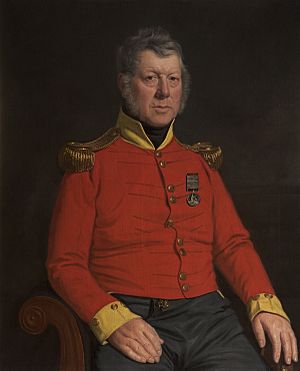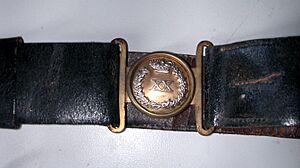Archibald Arnott facts for kids
Quick facts for kids
Archibald Arnott
|
|
|---|---|
 |
|
| Born | 18 April 1772 |
| Died | 1855 (aged 82–83) Ecclefechan, Dumfries, Scotland
|
| Occupation | British Army surgeon |
| Known for | Napoleon's doctor on St. Helena |
Archibald Arnott (born April 18, 1772 – died 1855) was a British Army doctor. He is most famous for being Napoleon's doctor on the island of St. Helena. He was also there when Napoleon's body was examined after his death. After his work, he went back to his hometown of Ecclefechan, Scotland, where he was buried.
A Doctor in the British Army
Archibald Arnott joined the British Army on April 14, 1795. He started as an assistant doctor with the 11th Hussars regiment. He was promoted to a full doctor on August 23, 1799. He traveled with his unit to Holland and was present at the attack on the defenses at Krabbendam.
Later, he moved to the 20th Regiment of Foot in Menorca. He was there during the attack on Alexandria. He continued to serve with the 20th Regiment in places like Malta, Sicily, and Calabria. He was also present at the Battle of Maida.
He stayed with the 20th Regiment during the Battle of Vimiera and the retreat from the Battle of Corunna. He also went with his unit on the Walcheren expedition. During this trip, many soldiers in his unit became very sick with a fever. In 1812, Arnott worked with the Duke of Wellington during his military campaigns. He served until the end of the war, including at the Battle of Vittoria, in the Pyrenees mountains, and in India.
Caring for Napoleon
Archibald Arnott was the fourth and last doctor to care for Napoleon on St. Helena. He arrived in 1819 with his regiment. On April 21, 1821, he began to visit Napoleon as his doctor. He quickly became very good friends with Napoleon. He was Napoleon's most trusted doctor and stayed with him until he passed away.
Napoleon was sick in bed for several days. He was throwing up a lot. Dr. Arnott gave him some medicines, but they didn't work at first. Finally, he gave Napoleon a medicine that helped him feel better. This medicine was likely a type of pain reliever.
On May 3, Arnott gave Napoleon medicine for his stomach problems, which worked well. Before he died, Napoleon asked for a snuff box. He carved the letter "N" into it with a small knife. He gave this box to Dr. Arnott. He also gave him a lock of his hair, two old pistols, and a handkerchief. The snuff box was last known to be with a British Army officer named Alan Cunningham. The pistols are now in a museum in Warminster, England.
After Napoleon died, Dr. Arnott made a special mask of his face. He used surgical wax because there was no plaster on the island. He signed the mask and wrote the date, May 6, 1821. This mask is now in a museum in Nice, France.
On May 3, 1821, Napoleon said that if he became unconscious, only Dr. Arnott should touch him. Napoleon died on May 5, 1821. Dr. Arnott was present for the examination of Napoleon's body after his death. Napoleon left Dr. Arnott 600 Napoleons (a type of money). The British government also gave him an extra payment of 500 British pounds.
Later Life and Writings
After his time in the army, Dr. Arnott retired to his home in Ecclefechan, Scotland. He collected many interesting stories from his time. In 1822, he wrote a book called "Account of the last illness, Decease, and Post-mortem appearances of Napoleon." This book described Napoleon's final sickness, death, and the examination of his body. Dr. Arnott was well-liked by the people in his town. He was buried in the churchyard in Ecclefechan.


